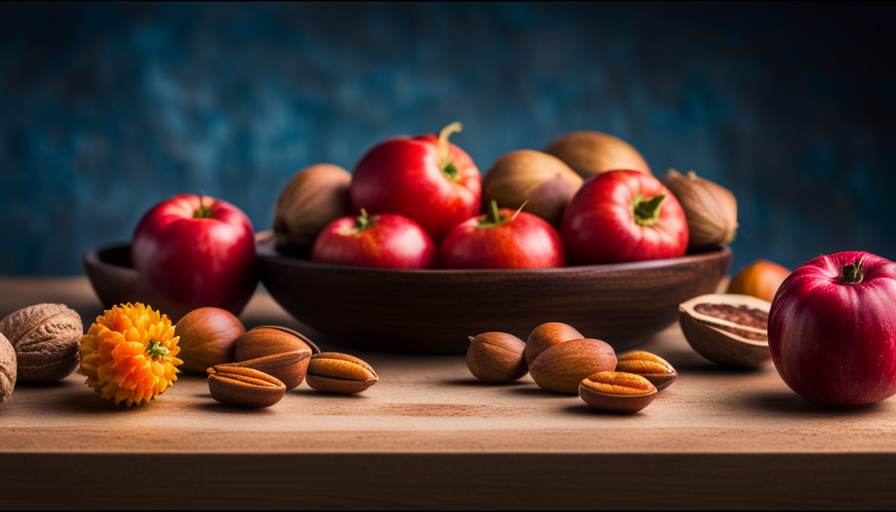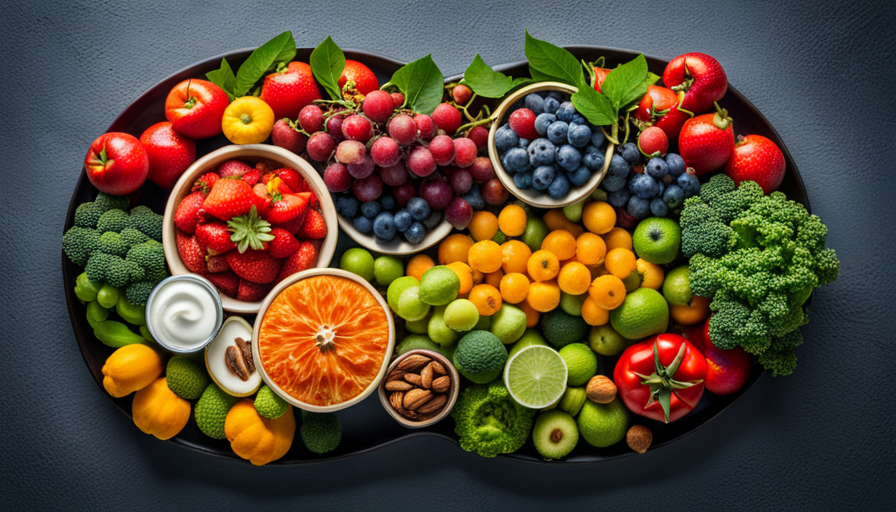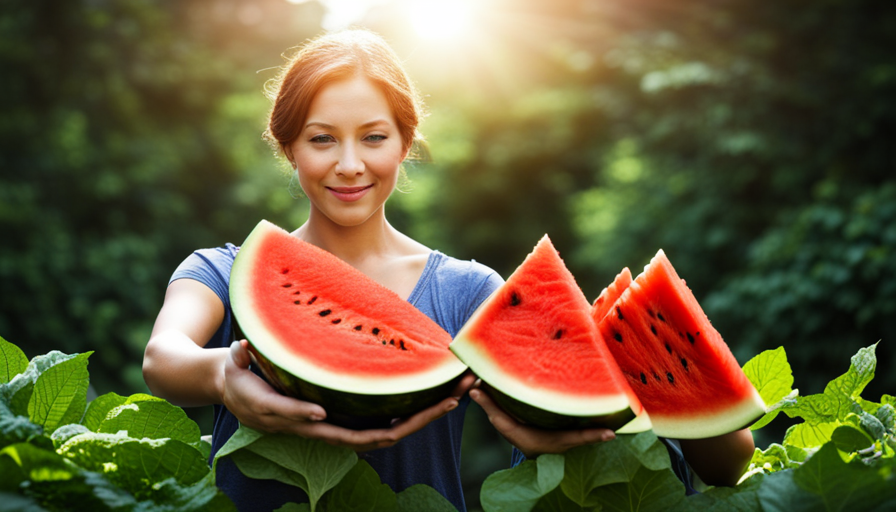Raw food is a term frequently mentioned in the realm of nutrition and health. However, what does it truly signify? For me, it goes beyond being a mere trend or dietary craze. It is a means of reconnecting with nature and embracing the genuine essence of food.
In a world where processed and packaged foods dominate our plates, eating raw is a revolutionary act. It’s about going back to basics and consuming food in its purest, most natural form. When we eat raw, we’re not just nourishing our bodies, but also our souls. We’re tapping into the incredible power of unadulterated nutrients and experiencing a vitality that can only be found in nature’s bounty.
So, join me on this journey as we explore the meaning of raw food, its benefits, and whether it’s the right choice for you. Get ready to embark on a path of health, wellness, and enlightenment.
Key Takeaways
- Raw food refers to uncooked fruits, vegetables, and meats.
- Cooking can cause the loss of essential nutrients in food.
- Raw food retains more natural vitamins, minerals, and enzymes.
- Raw food diets can improve digestion, increase energy levels, and enhance overall health.
Definition of Raw Food
Raw food, typically referring to uncooked fruits, vegetables, and meats, is often praised for its nutritional value and potential health benefits. When food is cooked, it can lose some of its essential nutrients due to the high temperatures involved in the cooking process.
Raw food, on the other hand, retains more of its natural vitamins, minerals, and enzymes that contribute to overall health. One of the major health benefits of eating raw food is the increased intake of enzymes. Enzymes are essential for digestion and the absorption of nutrients. By consuming raw food, we’re providing our bodies with a natural source of enzymes that can aid in digestion and improve nutrient absorption.
Additionally, raw food is high in fiber, which is important for maintaining a healthy digestive system. Fiber helps to regulate bowel movements and prevent constipation. It also promotes a feeling of fullness, which can aid in weight management.
However, it’s important to note that there may be potential drawbacks to consuming raw food. Raw meat, for instance, can contain harmful bacteria that can cause foodborne illnesses. It’s crucial to properly handle and prepare raw meat to minimize the risk of contamination.
Raw food offers numerous health benefits, including increased enzyme intake and high fiber content. However, it’s important to be aware of the potential drawbacks and take necessary precautions when consuming raw food.
Moving on to the benefits of eating raw food, it’s worth noting that…
Benefits of Eating Raw Food
Consuming uncooked and unprocessed food has numerous advantages. It boosts nutrient absorption and promotes a healthier digestive system. When we eat raw food, our bodies can absorb more nutrients from the food we consume. Cooking can sometimes destroy or reduce the levels of certain vitamins and minerals in our food. By eating raw, we ensure that these nutrients remain intact, allowing our bodies to fully benefit from them.
Here are some benefits of eating raw food:
-
Increased nutrient absorption: Raw food is rich in vitamins, minerals, and enzymes that are easily absorbed by our bodies. This can lead to improved overall health and increased energy levels.
-
Improved digestion: Raw food contains natural enzymes that aid in the digestion process. These enzymes help break down food and make it easier for our bodies to absorb nutrients.
-
Weight management: Raw food is generally low in calories and high in fiber, which can help with weight management. It can also help reduce cravings for unhealthy processed foods.
-
Reduced risk of chronic diseases: Eating a diet rich in raw fruits, vegetables, and whole grains has been linked to a lower risk of chronic diseases such as heart disease, diabetes, and certain types of cancer.
It is important to note that while raw food can have many health benefits, there are also potential health risks associated with consuming raw animal products or certain raw vegetables. Therefore, it’s essential to practice proper food safety and hygiene when consuming raw food.
Transition: Now that we understand the benefits of consuming raw food, let’s explore how it can also lead to increased nutrient intake.
Increased Nutrient Intake
By incorporating more unprocessed and uncooked ingredients into my daily meals, I can experience a significant boost in my nutrient intake, resulting in improved overall health and vitality. For example, imagine me adding a variety of vibrant, fresh fruits and vegetables to my breakfast smoothie, providing me with an array of essential vitamins and minerals to start my day on a nourishing note.
| Increased Nutrient Intake | Potential Health Risks |
|---|---|
| Higher vitamin content | Foodborne illnesses |
| More minerals | Nutrient imbalances |
| Increased fiber intake | Allergenic reactions |
Increasing my intake of raw food allows me to benefit from increased nutrient absorption. Raw fruits and vegetables retain more vitamins and minerals compared to cooked counterparts, as heat can denature or destroy certain nutrients. Consuming raw foods also provides a higher fiber intake, which aids in digestion and helps maintain a healthy weight. However, it is important to note that there are potential health risks associated with raw food consumption. Raw foods may contain harmful bacteria that can lead to foodborne illnesses. Additionally, consuming raw foods exclusively can result in nutrient imbalances and allergenic reactions in some individuals.
Transitioning into the subsequent section about ‘improved digestion,’ it is essential to understand how incorporating raw foods into my diet can enhance not only my nutrient intake but also my digestive health.
Improved Digestion
Incorporating more unprocessed and uncooked ingredients into my daily meals can lead to improved digestion, allowing me to truly savor the flavors and enjoy my meals to the fullest.
Raw foods are rich in essential nutrients that are often lost during cooking processes. By consuming these foods in their natural state, I’m providing my body with a higher concentration of vitamins, minerals, and enzymes. This increased nutrient intake promotes better absorption in the gut, ensuring that my body receives the maximum benefit from the food I consume.
Furthermore, raw foods are known to support a healthy gut microbiome. The gut microbiome consists of trillions of bacteria that play a crucial role in digestion and overall health. Raw foods contain beneficial bacteria and fiber that act as prebiotics, nourishing the existing gut bacteria and promoting a diverse and balanced microbiome.
This, in turn, enhances the digestion process and improves nutrient absorption.
With improved digestion and nutrient absorption, I can experience enhanced energy levels throughout the day. By fueling my body with raw, unprocessed ingredients, I’m providing it with the necessary nutrients to function optimally. This increased energy allows me to be more productive and active, leading to a healthier lifestyle overall.
Enhanced Energy Levels
Boost your vitality and feel like a human battery charged to full capacity by nourishing your body with the vibrant energy of natural, unprocessed ingredients. Raw food can enhance your energy levels, leading to increased focus and improved mood.
Here are three ways raw food can boost your energy:
-
Nutrient Density: Raw foods are rich in essential vitamins, minerals, and enzymes that can provide a quick and sustained energy boost. These nutrients are easily absorbed by the body, allowing for optimal energy production.
-
Hydration: Raw fruits and vegetables have high water content, helping to hydrate your body and maintain energy levels. Staying hydrated is crucial for cognitive function and can improve focus and mental clarity.
-
Blood Sugar Regulation: Raw foods, especially those low in glycemic index, can help stabilize blood sugar levels. This prevents energy crashes and mood swings often associated with processed foods.
By incorporating raw foods into your diet, you can experience increased focus and improved mood, allowing you to perform at your best throughout the day. However, it’s important to understand the potential risks of eating raw food, which will be discussed in the next section.
Incorporate raw food into your diet and unlock the energy-boosting benefits, but be aware of the potential risks involved.
Potential Risks of Eating Raw Food
Be cautious of the potential risks involved in enjoying the energizing benefits of incorporating raw ingredients into your diet. While there are potential health benefits to eating raw food, such as increased nutrient intake and improved digestion, it is important to be aware of the food safety concerns associated with consuming raw food.
One of the main concerns is the risk of foodborne illnesses. Raw food, especially raw meat, poultry, seafood, and eggs, may contain harmful bacteria like Salmonella, E. coli, and Listeria. These bacteria can cause severe gastrointestinal symptoms, such as nausea, vomiting, diarrhea, and abdominal pain. In some cases, they can even lead to more serious complications, especially in vulnerable populations such as young children, pregnant women, older adults, and those with weakened immune systems.
To minimize the risk of foodborne illnesses, it is crucial to handle raw food properly. This includes storing raw ingredients separately from cooked foods, washing hands and utensils thoroughly before and after handling raw food, and cooking certain ingredients to their recommended internal temperature to kill harmful bacteria.
In the next section, we will delve deeper into the topic of foodborne illnesses and explore the steps you can take to prevent them.
Foodborne Illnesses
One of the risks of consuming raw ingredients is the potential for foodborne illnesses, which can have serious consequences for vulnerable individuals. Food safety is of utmost importance when it comes to preventing these illnesses.
Raw foods, such as uncooked eggs, unpasteurized milk, and undercooked meats, can contain harmful bacteria like Salmonella, E. coli, and Campylobacter. These bacteria can cause symptoms like nausea, vomiting, diarrhea, and in severe cases, can even lead to hospitalization or death.
To minimize the risk of foodborne illnesses, several prevention measures should be followed. First and foremost, it’s crucial to practice good hygiene, such as washing hands thoroughly before and after handling raw ingredients. Additionally, ensuring that raw meats are cooked to the appropriate internal temperature can kill harmful bacteria. Using separate cutting boards and utensils for raw and cooked foods can also prevent cross-contamination.
Food safety is paramount when dealing with raw ingredients. Taking appropriate prevention measures can significantly reduce the risk of foodborne illnesses. However, it’s not only food safety that should be considered; nutrient deficiencies can also be a concern when relying solely on raw foods.
Nutrient Deficiencies
Nutrient deficiencies can arise when relying solely on raw ingredients, posing a potential risk to overall health and well-being. While raw food diets have gained popularity due to their perceived nutritional benefits, it is important to recognize that they may not provide all the necessary nutrients the body needs. Raw foods, such as fruits and vegetables, can be rich in vitamins, minerals, and enzymes that are beneficial for our health. However, certain nutrients, like vitamin B12 and iron, are more easily absorbed from cooked foods.
To illustrate the potential risks of relying solely on raw ingredients, consider the following table:
| Nutrient | Raw Food Source | Cooked Food Source |
|---|---|---|
| Vitamin B12 | Not present | Found in animal products |
| Iron | Less bioavailable | More bioavailable |
| Calcium | Less bioavailable | More bioavailable |
| Zinc | Less bioavailable | More bioavailable |
| Beta-carotene | More bioavailable | Less bioavailable |
This table demonstrates that while raw foods may provide some nutritional benefits, cooked foods often offer more bioavailable nutrients, which are easier for our bodies to absorb and utilize. Thus, relying solely on raw ingredients may increase the risk of nutrient deficiencies.
In the subsequent section about difficulty in digesting certain foods, we will explore how cooking can enhance the digestibility of certain ingredients.
Difficulty in Digesting Certain Foods
Have you ever experienced tummy troubles after eating certain foods that are difficult for your body to digest? Digestive difficulties can arise from difficulty in digesting specific proteins found in certain foods. When these proteins are consumed in their raw form, they can be even harder to break down, leading to discomfort and digestive disturbances.
To illustrate the impact of cooking on food digestion, let me paint a picture for you. Imagine sinking your teeth into a raw steak. As you chew, the tough fibers resist your efforts, making it challenging for your digestive system to access the nutrients within. Now, picture cooking that same steak. The heat breaks down the proteins, rendering them more tender and easier to digest.
Cooking not only alters the texture of food, but it also enhances its digestibility. Here are four examples of how cooking can improve the digestion of certain foods:
-
Steaming vegetables softens their cell walls, making them easier to break down.
-
Soaking legumes reduces the presence of anti-nutrients, aiding in their digestion.
-
Heating grains denatures enzymes that hinder digestion, making them more easily absorbed.
-
Boiling eggs coagulates proteins, making them more digestible.
Now that we understand the impact of cooking on digestion, let’s delve into the types of raw food diets.
Types of Raw Food Diets
Imagine exploring a world of vibrant and nourishing possibilities, where your plate becomes a canvas and your health is your masterpiece. Raw food diets offer a unique approach to nutrition, emphasizing the consumption of uncooked, unprocessed foods.
These diets are gaining popularity due to the numerous benefits associated with raw food consumption. Raw foods are known to retain their natural enzymes, vitamins, and minerals, which can be destroyed during cooking. By consuming raw foods, individuals can maximize their nutrient intake and enhance their overall well-being.
There are several types of raw food diets, each with its own set of guidelines and restrictions. Some popular examples include the raw vegan diet, which excludes all animal products, and the raw paleo diet, which allows for the consumption of raw animal products such as meat and eggs. Other variations include the raw vegetarian diet, which permits the consumption of raw dairy products, and the raw fruitarian diet, which primarily consists of raw fruits.
When preparing raw foods, it is important to utilize proper techniques to ensure safety and maximize nutrient retention. Common methods include juicing, blending, fermenting, and dehydrating. These techniques help to preserve the integrity of the raw foods while enhancing their flavors and textures.
As we delve into the world of raw vegan diets, we’ll discover the incredible benefits and delicious possibilities that await us.
Raw Vegan
Experience the vibrant and invigorating world of a raw vegan lifestyle, where your health flourishes and your taste buds dance with delight.
Incorporating a raw vegan diet into your life means consuming only uncooked, unprocessed plant-based foods. This way of eating isn’t just a culinary adventure, but also a fantastic way to nourish your body with essential vitamins, minerals, and enzymes.
Here are some reasons why the raw vegan diet’s worth exploring:
- Increased energy levels and improved digestion
- Weight loss and maintenance
- Enhanced immune function
- Reduced risk of chronic diseases
- Clearer skin and a radiant complexion
With the raw vegan diet, you have the opportunity to explore a wide range of flavorful and nutrient-packed raw food recipes. From refreshing salads and smoothies to creative raw alternatives for your favorite cooked dishes, the possibilities are endless.
As we transition into the next section about raw vegetarian, it’s important to note that while the raw vegan diet excludes all animal products, the raw vegetarian diet allows for the inclusion of raw dairy products and eggs. So, let’s delve into the world of raw vegetarian and discover the exciting possibilities it offers.
Raw Vegetarian
Get ready to tantalize your taste buds with the delectable combination of fresh, vibrant fruits and vegetables in the world of raw vegetarian cuisine. As a raw vegetarian, I’ve experienced the numerous benefits that come with this lifestyle. Consuming raw foods allows me to maximize the nutritional content of my meals, as cooking can often lead to nutrient loss.
Raw vegetarianism also promotes weight loss, as raw fruits and vegetables are low in calories and high in fiber, keeping me feeling full and satisfied. Additionally, the raw vegetarian diet is rich in antioxidants, which help to reduce inflammation and protect against chronic diseases.
When it comes to raw vegetarian recipes, the options are endless. From refreshing salads to creative raw pasta dishes made from zucchini noodles, there’s something for everyone. Raw vegan desserts are also a delightful treat, with options like raw cheesecakes made from nuts and dates or fruit-based ice creams.
Transitioning into the next section about ‘raw omnivore’, it’s important to note that while raw vegetarianism offers many benefits, some individuals may choose to incorporate raw animal products into their diet for added protein and nutrients.
Raw Omnivore
Now let’s delve into the world of raw omnivore cuisine, where individuals can enjoy a balanced diet that includes both raw plant-based foods and raw animal products for optimal protein and nutrient intake.
Raw omnivore diets are based on the principle that consuming food in its natural state preserves its nutritional value and enzymes. By incorporating raw plant-based foods, such as fruits, vegetables, nuts, and seeds, along with raw animal products like eggs, fish, and unpasteurized dairy, raw omnivores ensure they’re getting a wide range of essential nutrients.
Raw food diets, including raw omnivore diets, have gained popularity due to their potential health benefits. Advocates argue that raw foods retain more nutrients and enzymes that can improve digestion and overall health.
It’s important to note that while raw animal products can provide valuable nutrients, they also come with potential risks, such as foodborne illnesses. Therefore, it’s crucial to source high-quality, fresh, and properly handled animal products to minimize these risks.
Incorporating raw food into your diet can be done by gradually increasing the amount of raw fruits, vegetables, and animal products you consume. It’s essential to ensure proper food handling and hygiene practices, such as washing produce thoroughly and storing raw animal products at appropriate temperatures.
By following these guidelines, individuals can reap the potential benefits of a raw omnivore diet while minimizing the associated risks.
Tips for Incorporating Raw Food into Your Diet
To fully savor the benefits of a diet that celebrates the natural state of ingredients, one can effortlessly infuse their culinary choices with the vibrant essence of fresh and unprocessed nourishment. Incorporating raw food into your diet can be a wonderful way to enhance your health and well-being. Raw food recipes offer a variety of options that showcase the natural flavors and textures of ingredients, while also providing an abundance of nutrients. From refreshing salads to delicious smoothies, there are countless ways to enjoy raw food.
The benefits of raw food are plentiful. Raw ingredients retain their natural enzymes and nutrients, which can be destroyed through cooking. These enzymes aid in digestion and provide optimal nutrition for your body. Additionally, raw food is often lower in calories and higher in fiber, promoting weight loss and a healthy digestive system. It can also boost your energy levels and improve your skin complexion.
To further illustrate the benefits of raw food, consider the following table:
| Benefits of Raw Food |
|---|
| Retains enzymes and nutrients |
| Promotes weight loss |
| Boosts energy levels |
Incorporating raw food into your diet can be a gradual process. Start slowly by incorporating one raw meal or snack into your daily routine. As you become more comfortable, you can increase the amount of raw food in your diet. Transitioning to a raw food lifestyle can be a rewarding journey towards improved health and vitality.
Start Slowly
Take it easy and ease into incorporating more fresh, unprocessed ingredients into your diet. Starting slowly is key when it comes to introducing raw food into your daily meals. By gradually increasing the amount of raw food you consume, your body will have time to adjust to the change and you can avoid any potential digestive issues.
There are several benefits to starting slowly. First, it allows you to listen to your body and pay attention to any reactions or sensitivities you may have to certain raw foods. By starting with small portions and observing how your body responds, you can make adjustments and find what works best for you.
Second, starting slowly gives you the opportunity to experiment with different recipes and flavors. It can be overwhelming to completely overhaul your diet all at once, so taking it one step at a time allows you to explore new ingredients and find the ones you enjoy the most.
As you begin incorporating more raw food into your diet, it’s important to remember to start slowly and listen to your body. This will help you reap the benefits of starting slowly and make the transition to a raw food diet more enjoyable and sustainable.
Experiment with Different Recipes
Start by trying out various recipes and flavors to explore the wide range of options available when incorporating more fresh, unprocessed ingredients into your diet. Experimenting with flavors is an exciting way to discover new tastes and combinations that can make raw food enjoyable and satisfying.
You can start by adding different herbs and spices to your dishes to enhance the flavors. For example, try using fresh basil or cilantro in your salads or adding a pinch of cayenne pepper to your raw soups.
Another way to experiment is by trying unique ingredients that you may not have considered before. Incorporating fruits like mango or pineapple into your salads can add a burst of sweetness and tanginess. You can also try using spiralized zucchini or carrot noodles as a substitute for traditional pasta. These alternatives not only add variety to your meals but also increase your intake of vitamins and minerals.
As you experiment with different recipes and flavors, you will begin to develop a preference for certain combinations and ingredients. This will help you focus on fresh and organic produce, as you’ll have a better understanding of what works best for you.
By exploring the world of raw food, you can discover a whole new realm of culinary possibilities that aren’t only delicious but also nourishing for your body.
Focus on Fresh and Organic Produce
Indulge in the vibrant flavors and nourishing power of fresh, organic produce to unlock a world of culinary wonders that’ll ignite your taste buds and revitalize your health.
When it comes to raw food, the quality of the ingredients is paramount. Fresh produce, unlike its frozen counterpart, is bursting with flavor and retains more of its natural nutrients. Frozen produce, though convenient, often loses some of its taste and nutritional value during the freezing process.
Opting for fresh, organic produce ensures that you’re consuming food that’s been cultivated without the use of synthetic pesticides, herbicides, or genetically modified organisms. Organic farming promotes biodiversity, protects soil quality, and reduces pollution, making it an environmentally friendly choice.
Eating fresh, organic produce isn’t just beneficial for your health but also for the planet. By supporting organic farming practices, you contribute to the preservation of our ecosystems and the overall well-being of our planet. So, next time you shop for ingredients, consider reaching for fresh, organic produce to create delicious and nutritious raw meals.
Transitioning into the subsequent section about commonly consumed raw foods, let’s explore the wide array of options available for incorporating raw ingredients into your daily diet.
Commonly Consumed Raw Foods
After discussing the importance of focusing on fresh and organic produce, let’s now delve into commonly consumed raw foods.
When it comes to raw food, there are a plethora of options to choose from. Many people enjoy raw food recipes such as salads, smoothies, and sushi. These dishes not only provide a burst of flavors but also retain the maximum nutritional value of the ingredients.
However, it’s important to note that consuming raw foods may carry potential health risks. Raw eggs, for example, can contain harmful bacteria such as Salmonella, while raw fish may harbor parasites. It’s crucial to ensure the quality and freshness of the ingredients when preparing raw food recipes to minimize these risks.
Additionally, individuals with weakened immune systems, pregnant women, and young children should exercise caution when consuming raw foods.
Now that we have explored the commonly consumed raw foods and their potential health risks, let’s move on to the next section about fruits and vegetables, where we’ll uncover their role in a raw food diet.
Fruits and Vegetables
Now that we’ve covered the potential health risks of consuming raw foods, let’s explore the vital role that fruits and vegetables play in a raw food diet. Raw fruits and vegetables are packed with essential nutrients, enzymes, and antioxidants that are often lost during cooking. They provide a wide range of health benefits, including improved digestion, increased energy levels, and enhanced immune function. Incorporating a variety of fruits and vegetables into your raw food diet can help prevent chronic diseases and promote overall well-being.
To give you an idea of the nutritional value of different fruits and vegetables, here is a table showcasing some examples:
| Fruit | Benefits |
|---|---|
| Apples | High in fiber and antioxidants |
| Oranges | Rich in vitamin C and immune-boosting compounds |
| Spinach | Packed with iron and other essential minerals |
| Carrots | Excellent source of beta-carotene and vitamin A |
| Blueberries | Loaded with antioxidants and anti-inflammatory properties |
In addition to their health benefits, fruits and vegetables can be used in a variety of delicious raw food recipes. From refreshing fruit salads to colorful vegetable wraps, the possibilities are endless. Incorporating these raw food recipes into your diet can add flavor and excitement to your meals while providing you with essential nutrients.
Moving on to the next section about nuts and seeds, it’s important to note that they also play a crucial role in a raw food diet.
Nuts and Seeds
To truly elevate your raw food experience, you’ll be amazed at the incredible benefits that nuts and seeds can bring to your diet.
Nuts and seeds are not only delicious but also packed with essential nutrients that can contribute to your overall health and well-being. Raw nuts, such as almonds, walnuts, and cashews, are a great source of healthy fats, protein, and fiber. These nutrients can help promote satiety, support heart health, and improve digestion.
Additionally, nuts and seeds contain minerals like magnesium, zinc, and calcium, which are vital for maintaining strong bones and teeth.
Including raw nuts and seeds in your diet can also provide numerous health benefits. Research suggests that consuming nuts regularly may reduce the risk of chronic diseases, such as heart disease and diabetes. They can also help lower cholesterol levels and improve blood sugar control.
Furthermore, nuts and seeds are rich in antioxidants, which can protect your cells from damage caused by harmful free radicals.
Transitioning into the subsequent section about ‘sprouted grains and legumes,’ it is important to explore the benefits of incorporating these nutrient-dense foods into your raw food diet.
Sprouted Grains and Legumes
Including sprouted grains and legumes in your diet can provide a multitude of health benefits and enhance your raw food experience.
Sprouted grains are whole grains that have been soaked in water until they germinate. This process activates enzymes that break down starches and proteins, making the grains easier to digest and increasing nutrient availability. Sprouted grain recipes can include sprouted wheat, barley, and quinoa, which can be used in salads, soups, and even baked goods.
Sprouted legumes, such as lentils, chickpeas, and mung beans, are also highly nutritious. When legumes are sprouted, their nutrient content is enhanced, and the sprouting process helps to reduce anti-nutrients, making them easier to digest. Sprouted legumes can be enjoyed in salads, stir-fries, and as a topping for raw dishes.
The benefits of sprouted legumes include increased protein content, improved digestion, and enhanced nutrient absorption. They are also a great source of fiber, vitamins, and minerals. Incorporating sprouted grains and legumes into your raw food diet can add variety and flavor to your meals while providing essential nutrients.
Transitioning into the subsequent section about ‘raw food preparation techniques’, it’s important to know how to properly prepare raw foods to maximize their nutritional value.
Raw Food Preparation Techniques
Are you curious about the various techniques used to prepare raw foods to retain their maximum nutritional value? When it comes to raw food preparation, there are a few important factors to consider, especially in terms of raw food safety. Contrary to popular belief, raw foods can be safely consumed if proper precautions are taken.
It’s crucial to source fresh, high-quality ingredients and to follow proper hygiene practices during the preparation process. One common misconception about raw food is that it is devoid of flavor or variety. However, there are numerous ways to enhance the taste and texture of raw dishes.
Techniques such as marinating, fermenting, and dehydrating can add depth and complexity to the flavors. For example, marinating vegetables in a mixture of citrus juice, herbs, and spices can infuse them with vibrant flavors. Additionally, incorporating a variety of textures is key to creating satisfying raw meals.
Techniques like spiralizing, grating, and chopping can transform raw ingredients into diverse textures, allowing for a more enjoyable dining experience. By experimenting with different preparation techniques, you can create a wide range of delicious and nutritious raw dishes.
Now, let’s move on to the next section about juicing.
Juicing
Juicing offers a flavorful and convenient way to incorporate a wide variety of fresh fruits and vegetables into your diet. By extracting the juice from these produce items, you can enjoy concentrated nutrients in a liquid form.
One of the main benefits of juicing is that it allows you to consume a larger quantity of fruits and vegetables than you would typically eat in one sitting. This means you can easily meet your daily recommended intake of vitamins, minerals, and antioxidants. Additionally, juicing allows for better digestion and absorption of nutrients since the fiber has been removed.
There are countless juicing recipes available that cater to different tastes and health goals. For example, you can create a green juice by combining leafy greens like spinach and kale with cucumber, apple, and lemon for a refreshing and detoxifying blend. Or, if you prefer a sweeter option, you can juice carrots, oranges, and ginger for a delicious and immune-boosting concoction. The possibilities are endless, and experimenting with different combinations can make juicing an exciting and enjoyable part of your daily routine.
Transitioning to the subsequent section about blending, another popular raw food preparation technique, allows for the retention of fiber and a different texture to the final product.
Blending
Mixing ingredients in a blender allows me to create smooth and creamy concoctions that leave me feeling satisfied and energized. Blending techniques play a crucial role in preparing raw food smoothies.
When blending raw ingredients, it’s important to consider the texture and consistency desired. Blending at high speeds for a short duration can create a chunkier texture, while blending at low speeds for a longer duration results in a smoother, silkier texture.
By blending raw fruits and vegetables, I’m able to retain their nutritional value as the process doesn’t involve high heat that can destroy enzymes and vitamins. Additionally, blending breaks down the cell walls of the ingredients, making it easier for my body to absorb the nutrients. This allows me to benefit from the full range of vitamins, minerals, and antioxidants present in the raw food.
As I transition into the subsequent section about ‘dehydrating,’ I can explore another method of food preparation that retains the rawness and nutritional value of ingredients.
Dehydrating
To get the most out of your ingredients, try dehydrating them to create flavorful and nutritious snacks that are perfect for on-the-go munching. Dehydrating is a method of removing moisture from food, which not only extends its shelf life but also concentrates its flavors.
There are several dehydration methods available, including air drying, sun drying, and using a food dehydrator. Regardless of the method chosen, the process involves removing the water content from the food, resulting in a lightweight and easy-to-store product.
Dehydrated foods have numerous health benefits. Firstly, they retain most of their nutrients during the dehydration process, making them a nutritious snack option. Additionally, dehydrated foods are a great source of dietary fiber, which aids in digestion and promotes satiety. They are also packed with antioxidants that help protect the body against free radicals and boost the immune system. Furthermore, dehydrated snacks are typically low in calories and fat, making them suitable for weight management.
Transitioning to the subsequent section about raw food and weight loss, it’s important to note that incorporating dehydrated foods into a raw food diet can be a beneficial strategy.
Raw Food and Weight Loss
Incorporating dehydrated snacks into a weight loss plan can be a smart strategy for those looking to embrace a healthier lifestyle. Raw food, in particular, offers numerous benefits for weight loss.
Raw food is packed with essential nutrients and enzymes that support overall well-being. When consumed in its natural state, raw food can aid in weight loss by boosting metabolism and promoting satiety. Additionally, raw food is often low in calories and high in fiber, which can help control hunger and prevent overeating.
Raw food is not only beneficial for weight loss but also for mental and skin health. Research suggests that a diet rich in raw fruits, vegetables, and nuts can positively impact mental health by reducing symptoms of depression and anxiety. Furthermore, raw food is known to enhance skin health due to its high content of antioxidants and hydration. Many individuals who incorporate raw food into their diet report improvements in complexion and a reduction in skin issues such as acne and dryness.
Transitioning into the subsequent section about raw food and digestive health, it is important to note that raw food also plays a significant role in maintaining a healthy digestive system.
Raw Food and Digestive Health
Raw food and weight loss are often discussed together, but it’s important to note that the benefits of a raw food diet go beyond just shedding pounds. One area where raw food can have a significant impact is on digestive health.
When we consume raw food, we are providing our bodies with a rich source of nutrients, including fiber, which is crucial for maintaining a healthy gut. Raw food also contains enzymes that aid in digestion and promote the growth of beneficial gut bacteria. These bacteria play a vital role in our immune system, helping to fight off harmful pathogens and keeping us healthy.
Additionally, raw food is typically less processed, meaning it retains more of its natural nutrients and can be easier for the body to break down and absorb. So, by incorporating more raw food into our diets, we can support our digestive health and boost our immune system.
In the next section, we will explore whether raw food is the right choice for everyone.
Conclusion: Is Raw Food Right for You?
While the benefits of a raw food diet may seem appealing, it’s important to consider whether it aligns with your personal health goals and lifestyle, as only 3% of the population actually follows a raw food diet.
Raw food diets have gained popularity among athletes due to the belief that it enhances performance and promotes better recovery. However, there are potential drawbacks to consider.
One potential drawback of a raw food diet for athletes is the risk of inadequate nutrient intake. Raw food diets often exclude certain food groups, such as cooked proteins and grains, which can lead to deficiencies in essential nutrients like iron, calcium, and B vitamins. These nutrients are crucial for optimal athletic performance and recovery. Additionally, the high fiber content in raw foods can lead to gastrointestinal distress, including bloating and gas, which can negatively impact an athlete’s comfort and performance.
Another consideration is the risk of foodborne illnesses. Raw foods, especially raw animal products like eggs, meat, and fish, can contain harmful bacteria and pathogens that can cause food poisoning. While proper food handling and preparation techniques can minimize this risk, it is still something to be aware of.
While a raw food diet may offer some benefits for athletes, it is important to carefully consider the potential drawbacks. It is recommended to consult with a healthcare professional or registered dietitian before making any significant changes to your diet, especially if you are an athlete with specific performance goals.
Frequently Asked Questions
Are there any specific guidelines or recommendations for incorporating raw food into a diet?
Incorporating raw food into one’s diet can have specific benefits, such as increased nutrient intake and improved digestion. However, it’s important to be aware of potential risks associated with consuming raw food, such as foodborne illnesses from bacteria or parasites. To ensure safety, it’s recommended to thoroughly wash and prepare raw fruits and vegetables, as well as properly store and handle raw meats and seafood. It’s also advisable to consult with a healthcare professional or nutritionist for personalized guidance.
Can consuming raw food lead to weight loss?
Consuming raw food can potentially lead to weight loss. While raw food can be a healthy addition to a balanced diet, it is important to consider raw food safety and potential health risks.
Raw food diets may lack certain nutrients and increase the risk of foodborne illnesses. However, incorporating raw fruits, vegetables, and nuts into a well-rounded diet can provide essential vitamins, minerals, and fiber, which may contribute to weight loss when combined with a calorie-controlled eating plan.
How does eating raw food impact digestive health?
Eating raw food can have both positive and negative impacts on digestive health. On one hand, raw food retains its natural enzymes, which can aid in digestion and nutrient absorption. Additionally, raw food is often rich in fiber, which promotes healthy bowel movements.
However, consuming raw food also carries potential risks, such as foodborne illnesses from pathogens like bacteria and parasites. Therefore, it’s important to handle and prepare raw food properly to minimize these risks.
What are some commonly consumed raw foods?
There are several commonly consumed raw foods that offer numerous benefits. Fruits like apples and bananas are rich in vitamins and fiber. Vegetables such as carrots and cucumbers are packed with essential nutrients. Raw nuts and seeds provide healthy fats and protein.
Raw food benefits include improved digestion, increased energy, and better nutrient absorption. However, it’s important to ensure raw food safety by properly washing and storing these foods to prevent contamination.
Are there any specific preparation techniques for raw food?
There are specific recipes and preparation techniques for raw food that can enhance both its flavor and nutritional value.
Some examples include marinating vegetables in vinegar or citrus juices to add tanginess, or using a dehydrator to create crispy textures.
Many people choose to eat raw food for its numerous benefits, such as increased enzyme activity, higher nutrient content, and improved digestion.
These techniques allow individuals to enjoy a variety of delicious and nutritious raw meals.
What are the health benefits of incorporating raw food into my diet?
Incorporating raw food into your diet can have numerous health benefits. Raw food benefits and types include improved digestion, increased energy levels, better skin health, and a reduced risk of chronic diseases. Some popular raw food options include fresh fruits, vegetables, nuts, seeds, and sprouted grains.
Conclusion
In conclusion, raw food can be a great choice for those looking to improve their overall health and well-being. By consuming raw foods, individuals can benefit from increased nutrient intake, improved digestion, and enhanced energy levels.
While some may argue that raw food is difficult to incorporate into a busy lifestyle, it’s important to remember that there are many simple and convenient options available, such as pre-cut fruits and vegetables. So, don’t let time constraints hold you back from reaping the numerous benefits of a raw food diet. Give it a try and see the positive impact it can have on your health.










